From dodging falling bullets to breaking bread with Afghanistan’s national soccer team, May Jeong has the complete story of the remarkable run of a beleaguered nation.
It’s four hours to the game, and none of us have tickets. The match is a friendly between Afghanistan and Pakistan, a first in thirty-seven years.
The last time the two countries played each other, Afghanistan won 1-0. After the match, the country’s then-president Daoud Khan planted a kiss on the team captain who scored the winning goal. Two years later, Daoud Khan was killed in a communist coup, which also marked the death of modern sports in Afghanistan. Two years after that, the former captain fled to Germany, where he still drives a taxi.
Today, the two countries are uneasy neighbors: Kabul blames Islamabad for fueling the Taliban insurgency; Islamabad blames Kabul for the same. Artillery shells and rockets are fired across the disputed border on a regular basis.
For this reason, I worry about the game. We would be effectively locking ourselves in the great cavity of a stadium with thousands of Afghan men, many armed (there are weapons checks, but they’re haphazardly done) at an event pitting Afghanistan against its mortal enemy. If they win, the celebrations could get unwieldy: can the stadium, still under construction, withstand the weight of thousands of chanting, cheering fans? If they don’t, will it metastasize into a rampaging brawl? What if a young police recruit’s nervous finger slips on a trigger? A security monitoring service that many foreigners subscribe to sends out a threat warning; we are advised to avoid the area until further notice.
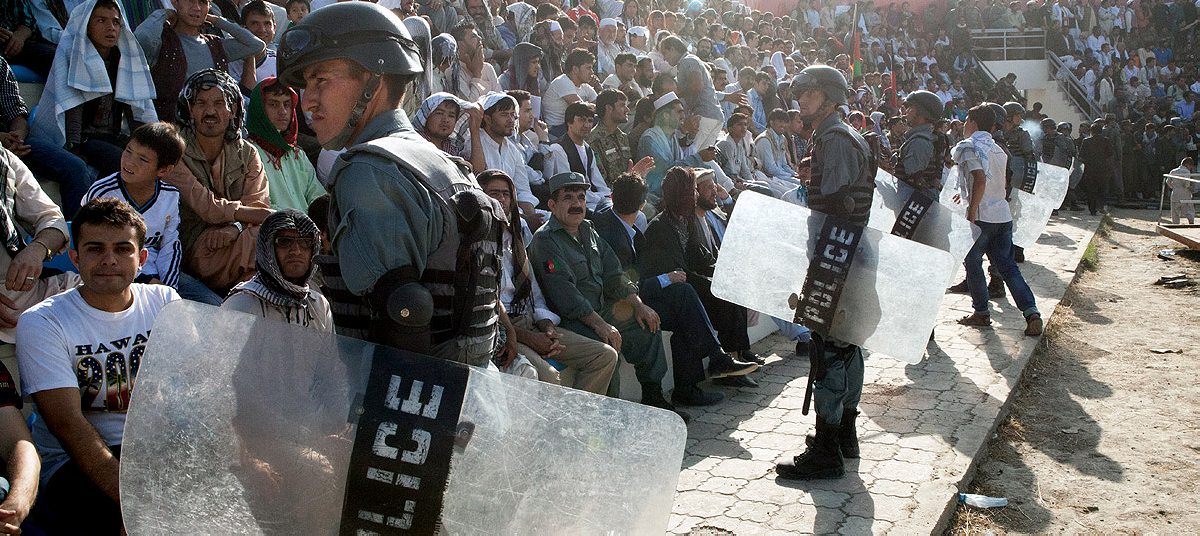
I am revisiting scenes of rioting mobs from Among the Thugs, Bill Buford’s masterful book on football hooliganism in Britain, when a friend of a friend of a friend comes through with the tickets. We are five people; all men except for myself. We nervously joke about how this, going to a soccer game, may be the most dangerous thing we’ve ever done in Kabul.
Out in the streets, the already interminable Kabul traffic has reached a new nadir, with thousands setting out to watch the game. The stadium within sight, we decide to leave our cars and continue on foot. We walk past police in full riot regalia, reinforced by soldiers with truck-mounted heavy machine guns.
Construction at the Afghan Football Federation stadium isn’t quiet complete—the sidewalks remain unpaved—but the organizers may have chosen this venue over the nearby Ghazi stadium, which has a bigger capacity (25,000 compared to 8,000) because they wanted to avoid the darker memories of Ghazi, which the Taliban used to carry out public executions. (That bit of context would make it into every single article, anyway.)
On the gravel path leading up to the entrance, we pass eight Porta Potties meant to service the 8,000 spectators. Going through my camera later that day, I notice that there are half a dozen out-of-focus shots of the ground, taken to prove to guards at every checkpoint that I am indeed carrying a camera, not a camera-borne improvised explosive device.
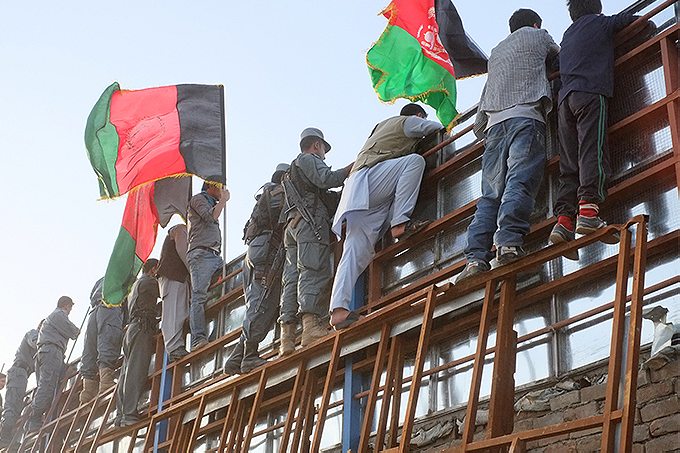
Atop the stadium, snipers are perched at every corner. Three hundred police officers ring the pitch. Their primary weapons are not pistols, like the officers in my genteel Canadian hometown, but automatic rifles. Security men in civilian clothes are also armed, with handguns tucked into the small of their backs.
When the Afghan national team steps on to the AstroTurf, the fans rise to cheer. They do not stand for the Afghan national anthem, however, when it plays on a tinny sound system. Patriotism, at least for now, remains a western concept. Many of the supporters traveled hours at great personal risk or closed down shops at the loss of daily income to attend today’s game. For the national team, this will be their first game in the motherland. A U.S. Black Hawk shears the sky in half.
The Taliban never had a fatwa, but the spirit of the game gradually died
The story of soccer in Afghanistan is the story of holding on to small articles of faith, despite circumstances. In 1922—just three years after independence—one of the first actions of the autonomous Afghan state was the creation of a football federation. That year, King Amanullah, the country’s great modernizer, built the Ghazi stadium. The first soccer club was founded in 1934, and the country’s first international match was with Iran in 1941. Afghanistan joined FIFA in 1948, and that year, participated in the London Olympics. The sport continued to grow popular through the 60s and 70s, but under the Soviet occupation and in the civil war that followed, everything was reduced to rubble. The Taliban never had a fatwa, but Mullah Omar forbade public matches during prayer time, and the spirit of the game gradually died.
“Under the Taliban, we still hosted games, but we were open only in name. We organized games for the Taliban, but they were a tool to bring people to the executions,” Ali Askar Lali of the Afghanistan Football Federation told me, referring to the practice of executing those deemed morally corrupt during half time.
For a while, public executions were the only entertainment available under the Taliban regime.
One of the most enduring images from the Taliban era was a grainy clip of an anonymous woman kneeling on the penalty spot of the Ghazi stadium, moments before being publicly executed by a Taliban gunman. After she was shot, the 30,000 something spectators rose to get a better look. For a while, public executions were the only entertainment available under the Taliban regime.
The Afghan national team reassembled after the fall of the Taliban, when they played South Korea in 2002. But in 2005, during the team’s first visit to Europe, nine players disappeared in Italy. The team disbanded, and it did not play again until 2007.
In the past few years, soccer has been making a comeback in Afghanistan. Today, much of the country is cleaved along lines of club loyalty. Are you a Real Madrid or an FC Barcelona? My Dari language tutor keeps me updated on bets he makes with his friends. The loser pays his debts with watermelon.
Afghanistan’s first premier league was founded last year by Roshan, the country’s largest telecommunications provider, and Moby Group, its largest media company. To engage the public, Moby launched a reality TV show in which viewers could participate by casting their votes on their favorite players. Eight teams were created to represent different regions of the country—as opposed to sects, tribes, or ethnicity, the usual fault lines in Afghanistan.
Saad Mohseni, chairman and CEO of Moby, says the idea for APL came from that powerful thing, nostalgia. “I remember being a 10-year-old boy and going to the stadium to watch the game. Those memories stayed with me.”
Radicalism is a byproduct of kids not having anything to do,” replied Saad Mohseni.
In recent years, he would see children get out of school with nothing to do and he worried for them. “Radicalism is a byproduct of kids not having anything to do. We have to create role models for them. What will the posters that they have in their homes be? Will it be bin Laden, or will it be sports heroes?”
He sounds clipped and certain as he tells me, “Sports are very important for any nation. Soccer, especially, has always been popular here, and what we’ve done is rekindle that interest. It is not a new game in this country.”
Besides, “[Soccer] is a simple game. You can play it in busy streets. You don’t need a bat. All you need is the ball.”
Back at the stadium, twenty minutes after kickoff, striker Sanjar Ahmadi delivers Afghanistan’s first goal. The stadium erupts into deafening applause. Excitement even stirs the press gallery. One Afghan female reporter has given up pretenses of objectivity entirely and dons face paint in the colors of the national flag. Ten minutes after that, midfielder Ahmad Hatifie scores again. Fans collapse into each other, embracing, incredulous.
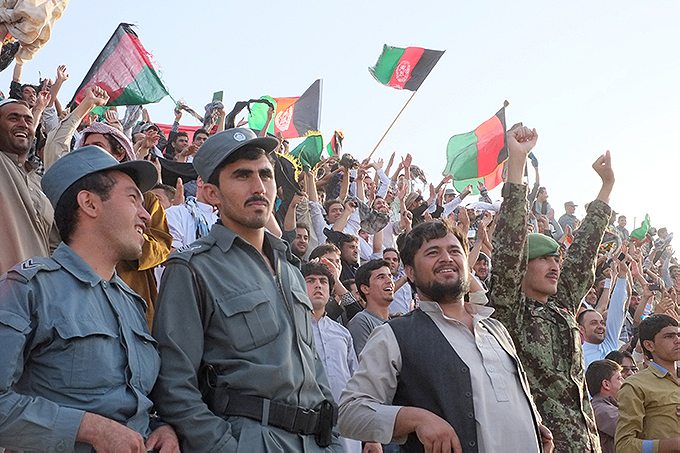
Meanwhile, the stadium has been steadily filling up, and is now over-capacity. Rumors say more tickets were sold than there were seats. Armed guards lock up the iron gate, but the unruly masses swell, and begin slamming into the gate with force.
They have gathered the loose beams and iron rebar protruding from the half-finished construction site and have begun to pry open the gate.
Then, suddenly, the gate comes off at the hinges, and the angry mob begins pouring in. Men are pressing against the now-untethered gate, which serves as the only barrier between the organized chaos inside the stadium and the unchecked madness beyond the gate. The officers push, and so do the desperate fans. The two factions are now moving in unison to create a sort of ebb and flow of human tide.
A tense moment comes when one of the soldiers climbs onto a bureau, and with his Kalashnikov cocked, points the gun toward the men. He releases the safety and holds it there.
The men back off. The moment passes.
Moving quickly now, a sentry pushes the bureau in front of the gate and wedges a wooden shaft to keep the gate secure. It doesn’t look too secure, and predictably enough, only a few minutes later, the fans win out, and the gate flings open again. There are men in blazers, men with canes, men with prosthetic limbs. In this way, the stadium continues to fill up while the game continues.
At half time, I snake through the unruly throng to the women’s section of the stadium. From this much calmer, saner place, the rest of the stadium seems to have a liquid consistency — a great blur of red, green and black, colors of the Afghan flag.
I hate to reinforce the stereotype, but the approximately two hundred female fans who are present are not visibly into the game. Many are treating this as a great big outdoor picnic. It is an occasion to break bread in the open air, to catch up on gossip, away from the demands of men in their lives. Many of them seem to have consumed sinful amounts of Cheetos—a bag must be going around— and they ask me if I’d like some, with neon orange crumbs lining their lips.
Back on the turf, in the final few minutes, midfielder Marouf Mahmoudi scores again for Afghanistan, and the game ends, 3-0. Afghanistan has just beat Pakistan. It is an incredible feat, especially for a team of unpaid players, assembled together just days beforehand.
We leave the stadium immediately to avoid being trampled by the euphoric party.
We leave the stadium immediately to avoid being trampled by the euphoric party. Those who weren’t successful in joshing their way into the stadium have scaled the outer walls and are straddling the ramparts to watch the game. A schoolboy whose arms aren’t quite strong enough is helped by a police officer, who lends him a hand and pulls him up.
As we amble along, empty water bottles are flung over the walls like weightless, impact-less mortar rounds. The dust storm picks up.
Hours after the match, the city will remain ablaze, its people experiencing a happiness so unadulterated, a joy so rare, that they will whoop and whistle well into the night.
Later, I will learn that the game, which was live streamed on Moby’s Tolo TV, was the single most-watched program in Afghan broadcast history, with 12.2 million people tuning in. I will also learn that it catapulted Afghanistan’s FIFA ranking from 186th to 139th.
In the six weeks since the game, I have witnessed soccer go from a child’s pastime into a national obsession. The previously oft-played but rarely-worshipped game now brings tears to the eyes of wizened men who lived through three decades of destruction in this country. During this time, I glimpsed the beginnings of national identity —something Western nations have spent millions to cultivate — born almost over night during a game of soccer.
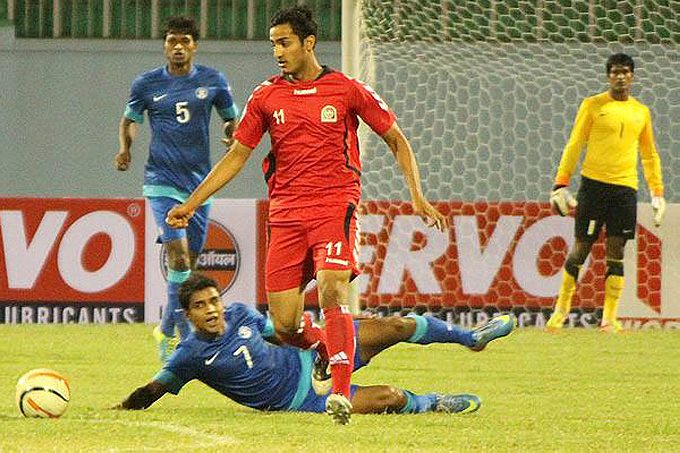
The week after Afghanistan’s blazing victory over Pakistan, I meet with Mohammad Mashriqi, a 26-year-old Afghan American who plays midfield for the Afghan national team. We are in head coach Mohammad Kargar’s office, where a chai bacha, or tea boy, who can’t be more than seven, serves me a lunch of kabuli pulao and kofta, Afghan pilaf and meatballs.
Mashriqi, the substitute Phys. Ed. teacher from Queens turned national hero, has been busy lately. He and the team have been invited to dine with the president, ministers, parliamentarians, bankers, and businessmen. Gifts—cash, clothes, certificates—have been pouring in. “The celebration went all day, all night, the next morning, even up until today,” Mashriqi says. “For me, it was a dream come true.”
Mashriqi comes from a family of soccer lovers. His father played for the national team, and his grandfather before that was a prominent local leader who supported the game. There are still tournaments held under his name in Kandahar today. Like many tribal elders, he was arrested by the communist regime, and his family never found out what happened to him. The family fled soon afterward and settled in Flushing, Queens. There, Mashriqi’s father founded a club in honor of the grandfather. That club is now made up entirely of Mashriqis, cousins and brothers and uncles of the one I am speaking to.
Tomorrow, the team will fly to Nepal for the South Asian Football Federation Championship, the region’s largest soccer tournament.
Is he excited? Not really. “I was going to tell the coach that I don’t want to come to practice tomorrow, I have stuff to do before I leave. I have to go shopping.”
Mind you, this is in August. Everyone I spoke with—Mohseni, Kargar, even the players themselves—assume the team is going to disperse after the tournament in Nepal. Back then, no one foresees what is about to come.
The next day, Afghanistan’s national team flies to Kathmandu. On the second of September, Afghanistan beats Bhutan 3-0. Next, they topple Sri Lanka 3-1. The September 6 match with Maldives is a draw, but this advances them to the semi-finals, where Afghanistan wins over Nepal by one goal. Then, on the twelfth anniversary of 9/11, the team crushes regional superpower India, 2-0. Afghanistan is this year’s South Asian football champion; the country dissolves into a state of rapture.
All of Afghanistan appears to be huddled in front of TV screens to watch the game.
On the evening of the championship match, all of Afghanistan appears to be huddled in front of TV screens: big and small, grainy and high-definition, in restaurants, in shops, at roadside stalls, inside guard boxes and living rooms. An outdoor screen has been installed in my neighborhood park, where men gather to watch the game.
Within minutes of kick-off, midfielder Mustafa Azadzai delivers Afghanistan’s first goal. Sanjar Ahmadi extends this lead with a second goal during the second off, driving his country to a stunning victory over India, a two-time defending champion. It is the country’s first-ever international soccer title.
The game is nearly over when I hear a police siren followed by gunshots. I sit up sharply and text my boyfriend who is in the provinces conducting research. He tells me to watch out for popcorn sounds. The screeching of tires and honking of horns take over, but then: popcorn sounds. From inside the house, it is difficult to discern, but soon I realize that this is the sound of Kabul celebrating.
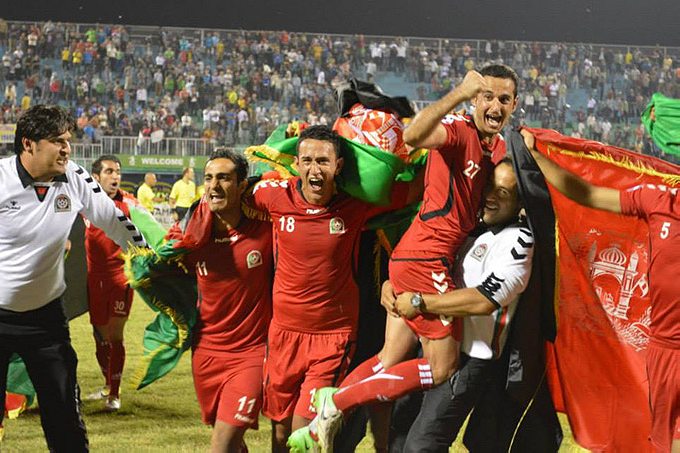
Men begin streaming out into the streets. Kabul is a place where crowds are normally associated with danger, but this time, the public outpouring seems oddly appropriate. The gold-tasseled Afghan flag gets passed around from truck to taxi to sedan, and the passengers sing a new football anthem that was recorded by Afghan pop stars, yet another sign of a changing Afghanistan. On Twitter, someone says they saw an old man swilling vodka in downtown Kabul, a rare scene indeed.
After the Interior Ministry gives the official go-ahead for celebratory shots, Kabul goes wild. The air smells of gunpowder, and tracer rounds light up the night sky. Again on Twitter, someone notes that the heaviest volleys of tracer fire are coming from police stations across town. Each shot raises the pitch of fervor, yet no one ducks for cover.
My elderly cat, who is ten and has probably witnessed her share of gunfights, cannot tell the difference between celebratory gunfire and real battles. She cowers, giving off a throaty howl of total terror. I let her into a cupboard in the kitchen, where she stays for the balance of the evening.
Like so many things in this country, the celebrations are a strictly male spectacle. There are scattered accounts of women in the streets. I would have been allowed out on the streets, but wouldn’t have felt safe.
I sit in my living room and read strangely moving Tweets like this one from Javid Faisal, spokesperson for the governor of Kandahar: “I will not post any casualty reports for 24 hours as I am celebrating.”
I was amazed to learn that only five people were hospitalized by falling bullets.
Tonight, I learn that all of my neighbors have AK-47s. An absurd amount of ammunition is being spent, making this perhaps the most successful disarmament campaign in Afghan’s history. I am amazed when I learn that only five people were hospitalized by falling bullets across the city.
I fall asleep to men shouting Allahu Akbar, God is great. The city hums with goodwill.
When the team flies back to Kabul the next morning, the reclusive President Hamid Karzai leaves his palace to greet the players at the airport, an honor he hasn’t extended to other heads of states.
Anyone who is anyone in Afghanistan all insists on hosting the national team. Whole classrooms full of students abandon their studies and run off to the stadium, where the players are hosting public celebrations.
President Karzai also wires $20,000 to the goalkeeper who saved multiple penalty kicks in the semi-final and final games. He then awards $1750 in cash, and new apartments, to every player.
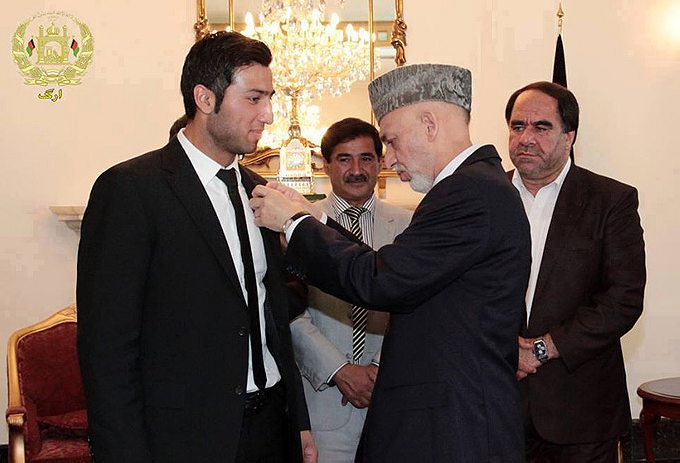
The gifts keep pouring in. Businessmen in Herat collect $100,000 for the team, and its mayor pledges another $20,000.
This is much welcomed by the national team, whose members have yet to be paid a salary or a consistent wage by the Afghan football federation, which, like every other football association in the world, was broke. “No government, no federation, no anybody pay to the national team,” remarked coach Kargar. (In comparison, in 2010-11, then captain of the US men’s national soccer team, Carlos Bocanegra, earned $350,000, with an additional $347,583 in bonuses.)
A few days after the championship victory, I am sitting at a bank, waiting to pay my bills, when I catch a video clip on Tolo TV. It is a series of short clips, beginning with one of a Taliban publicly flogging a woman on the street, then the Twin Towers falling, NATO bombing of Afghanistan, Hamid Karzai in his trademark chapan outfit, Afghans at the ballot box — and then, a long sequence of B-rolls from the Afghan national soccer team’s victory from just a few days ago.
Being an Afghan now also meant being the region’s ruling master of the beautiful game.
In just over 48 hours, soccer had become part of the national narrative. Along with having endured the Communist coup, the Soviet invasion, the Taliban takeover, string of civil wars, and the current NATO intervention, being an Afghan now also meant being the region’s ruling master of the beautiful game.
***
I have always intellectually known that soccer is the most democratic sport. The poorest children can become star players. The sport can be practiced under the most humble circumstances, on almost any surface.
But I never entirely understood what any of that meant until I came here. In a country where per capita GDP in 2010 was $528, and where a day laborer could make as little as a dollar or two a day, a game that requires no gear, nothing but a ball and willing participants, is a wonderful thing. One example: the other day, I noticed that the USAID-funded basketball court in our neighborhood had been converted, by ordinary people, into a soccer pitch.
A few days ago, I was back at the stadium, this time to watch a national league match between team Kabul and team Herat. I had a VIP ticket, which meant I got to sit in a throne-like seat, where they served green tea in ornate cups and assorted pastries on real china. Needless to say, nobody drinks beer at an Afghan football match.
None of the players have any dramatic flourish; nor do any of them have tattoos or a mohawk. There are no arch rivalries, no signature moves, yet. There is also none of the corruption or violence that soccer has come to be associated with in certain parts of the world. The game hasn’t been appropriated by the ultra nationalists who will use it as an occasion to exercise a destructive, violent form of patriotism. It’s also not feeding a crime syndicate that is remotely rigging bets from Singapore. Everything is refreshingly raw.
I rustle up some late-night snacks and invite the players over to hang out.
The players often pass balls to the member of the opposite team, or try tricks that fail. But there is a certain sweetness to it, how earnest everything seems. And so you don’t have the heart to remind your Afghan friends that the national team lost to Palestine in the World Cup qualifier back in 2011. Or that the Pakistan national team they defeated did not include the players who live and play abroad. Or that nobody outside of South Asia cares about being a South Asian champion.
The next time I see Mashriqi, the player from Queens, he is just returning from seeing President Karzai. I rustle up some late-night snacks (camembert and water biscuits, dried mulberries and almonds), call up a few friends, and invite the players over to hang out.
Some time in the night, I am talking to Ahmad Hatifie, the 27-year-old midfielder from Alameda, California, who scored the second goal in the Af-Pak friendly. I ask what the past few weeks have been like for him. “It was an unbelievable experience, to wear the jersey of your country and to play on the home pitch to a sold out crowd…” But then he can’t seem to continue, and I drop the subject. Conversation drifts toward the usual topics in Kabul: girl’s education, the latest suicide attack.
Some time later, Hatifie, who also holds down a job as an account manager, sends me an email. He writes, “It is difficult to put in words the feeling or emotion behind all this recognition. I can understand the tough task you have trying to put this to words.”
He goes on to describe the day the national team arrived back in Kabul, victorious. After the presidential greeting at the airport, the team rode bulletproof Land Cruisers to Ghazi stadium where it seemed like all of Kabul was waiting to congratulate them. A trip that should have taken twenty minutes stretched to more than three hours because of “people on the streets dancing, singing, crying in joy.” Fans climbed the roof, the hood, the running board of the cars and began banging on the windows—so hard that sheets of the bullet-resistant glass shattered. He counted thirty people on top of one Land Cruiser. A video from his Instagram account shows a clip of the stadium upon their arrival, a crush of humanity. You couldn’t see a single empty patch on the pitch. At least a dozen people had climbed lighting poles just to get a better look at their national heroes.
“The feeling behind all of this is surreal. It is indescribable. I still cannot believe that we have been apart of something this big,” Hatifie wrote. “I would have never thought that we would bring this much joy to the people that have suffered so much.”
Top photo by Graeme Smith
